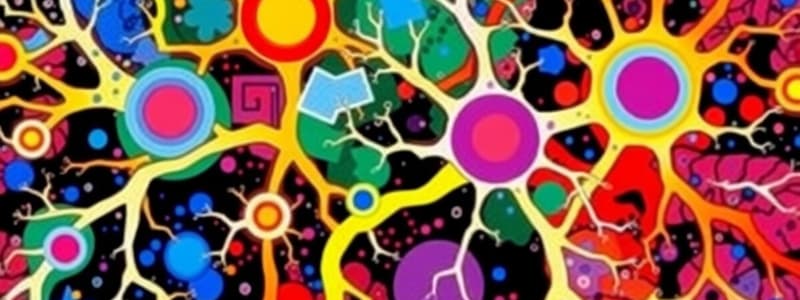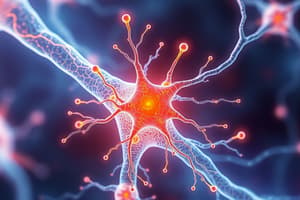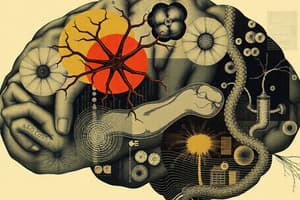Podcast
Questions and Answers
Which part of the neuron is primarily responsible for collecting incoming signals?
Which part of the neuron is primarily responsible for collecting incoming signals?
- Dendrites (correct)
- Presynaptic terminal
- Axon hillock
- Node of Ranvier
What type of neuron is characterized by having multiple dendrites and is the most common type found in the nervous system?
What type of neuron is characterized by having multiple dendrites and is the most common type found in the nervous system?
- Unipolar
- Bipolar
- Pseudounipolar
- Multipolar (correct)
What is the role of the axon hillock in a neuron?
What is the role of the axon hillock in a neuron?
- Communication site with other neurons
- Protection of the neuron
- Integration center for incoming signals (correct)
- Release of neurotransmitters
In which region does the presynaptic terminal function?
In which region does the presynaptic terminal function?
Which type of neuron has two axon roots and plays a significant role in sensory signaling?
Which type of neuron has two axon roots and plays a significant role in sensory signaling?
What function does the Node of Ranvier serve in a neuron?
What function does the Node of Ranvier serve in a neuron?
What characterizes a bipolar neuron in terms of structure?
What characterizes a bipolar neuron in terms of structure?
Which part of a neuron directly communicates with the postsynaptic cell?
Which part of a neuron directly communicates with the postsynaptic cell?
What are local potentials characterized by?
What are local potentials characterized by?
Which of the following is NOT a typical type of local potential?
Which of the following is NOT a typical type of local potential?
What happens to a local potential when a stimulus causes hyperpolarization?
What happens to a local potential when a stimulus causes hyperpolarization?
What type of local potential is generated through the binding of neurotransmitters?
What type of local potential is generated through the binding of neurotransmitters?
In terms of excitatory and inhibitory effects, local potentials can be described as:
In terms of excitatory and inhibitory effects, local potentials can be described as:
What is the primary function of myelinating neuroglia?
What is the primary function of myelinating neuroglia?
Which of the following accurately describes the function of oligodendrocytes?
Which of the following accurately describes the function of oligodendrocytes?
What is the primary difference in the myelination process between Schwann cells and oligodendrocytes?
What is the primary difference in the myelination process between Schwann cells and oligodendrocytes?
What are the consequences of demyelination in a neural pathway?
What are the consequences of demyelination in a neural pathway?
Which condition is characterized by the destruction of oligodendrocytes?
Which condition is characterized by the destruction of oligodendrocytes?
What is the primary component of myelin that contributes to its insulating properties?
What is the primary component of myelin that contributes to its insulating properties?
In which type of neural tissue would you predominantly find gray matter?
In which type of neural tissue would you predominantly find gray matter?
Which type of signs are expected in demyelinating diseases affecting the peripheral nervous system?
Which type of signs are expected in demyelinating diseases affecting the peripheral nervous system?
What primary function do astrocytes serve in the central nervous system?
What primary function do astrocytes serve in the central nervous system?
Which type of tumor is associated with oligodendrocytes?
Which type of tumor is associated with oligodendrocytes?
What is a defining characteristic of glioblastoma multiforme?
What is a defining characteristic of glioblastoma multiforme?
Which neuroglial cells are primarily responsible for immune functions in the CNS?
Which neuroglial cells are primarily responsible for immune functions in the CNS?
How do astrocytes contribute to the regulation of the extracellular environment in the CNS?
How do astrocytes contribute to the regulation of the extracellular environment in the CNS?
Which cells are involved in pruning weak neuronal synapses during development?
Which cells are involved in pruning weak neuronal synapses during development?
What type of tumor is usually involved in aggressive growth within the brain and spinal cord?
What type of tumor is usually involved in aggressive growth within the brain and spinal cord?
What is the primary role of satellite cells in the peripheral nervous system (PNS)?
What is the primary role of satellite cells in the peripheral nervous system (PNS)?
What is the primary role of summation in neuronal signaling?
What is the primary role of summation in neuronal signaling?
What initiates the fast depolarization phase of an action potential?
What initiates the fast depolarization phase of an action potential?
What phenomenon occurs in myelinated axons that increases conduction speed?
What phenomenon occurs in myelinated axons that increases conduction speed?
During which phase of an action potential does hyperpolarization occur?
During which phase of an action potential does hyperpolarization occur?
What is the resting membrane potential (RMP) of a neuron typically considered to be?
What is the resting membrane potential (RMP) of a neuron typically considered to be?
What triggers the release of neurotransmitters from synaptic vesicles?
What triggers the release of neurotransmitters from synaptic vesicles?
What type of injury is associated with antipsychotic medication in the context of schizophrenia management?
What type of injury is associated with antipsychotic medication in the context of schizophrenia management?
What is the result of the efflux of K+ ions during the action potential process?
What is the result of the efflux of K+ ions during the action potential process?
What is the expected effect of a dopamine antagonist on movement and behavior in patients?
What is the expected effect of a dopamine antagonist on movement and behavior in patients?
What characterizes the 'all-or-none' principle of action potentials?
What characterizes the 'all-or-none' principle of action potentials?
What is a key characteristic of hypertonicity in the context of neurological injuries?
What is a key characteristic of hypertonicity in the context of neurological injuries?
What is the role of myelin in the nervous system?
What is the role of myelin in the nervous system?
What type of medication is botulinum toxin considered in relation to neuromuscular function?
What type of medication is botulinum toxin considered in relation to neuromuscular function?
Which statement best describes the consequences of dysfunction in myelin?
Which statement best describes the consequences of dysfunction in myelin?
What can be expected from the medication effects on neurotransmitters?
What can be expected from the medication effects on neurotransmitters?
How do action potentials contribute to neural communication?
How do action potentials contribute to neural communication?
Flashcards
Axon
Axon
The output site of a neuron, extending from the soma and transmitting signals to other cells.
Synapse
Synapse
A junction where a neuron communicates with another neuron or a target cell. It involves the release of neurotransmitters.
Axon hillock
Axon hillock
The specialized region of the soma where the axon originates. It plays a vital role in initiating action potentials.
Soma
Soma
Signup and view all the flashcards
Dendrites
Dendrites
Signup and view all the flashcards
Multipolar neuron
Multipolar neuron
Signup and view all the flashcards
Bipolar neuron
Bipolar neuron
Signup and view all the flashcards
Pseudounipolar neuron
Pseudounipolar neuron
Signup and view all the flashcards
Neuroglia
Neuroglia
Signup and view all the flashcards
Myelinating Neuroglia
Myelinating Neuroglia
Signup and view all the flashcards
Oligodendrocytes
Oligodendrocytes
Signup and view all the flashcards
Schwann cells
Schwann cells
Signup and view all the flashcards
Myelin sheath
Myelin sheath
Signup and view all the flashcards
White matter
White matter
Signup and view all the flashcards
Gray matter
Gray matter
Signup and view all the flashcards
Demyelinating diseases
Demyelinating diseases
Signup and view all the flashcards
What are neuroglia?
What are neuroglia?
Signup and view all the flashcards
What are astrocytes?
What are astrocytes?
Signup and view all the flashcards
What are satellite cells?
What are satellite cells?
Signup and view all the flashcards
What are microglia?
What are microglia?
Signup and view all the flashcards
What is glioblastoma multiforme?
What is glioblastoma multiforme?
Signup and view all the flashcards
What is astrocytoma?
What is astrocytoma?
Signup and view all the flashcards
What is oligodendroglioma?
What is oligodendroglioma?
Signup and view all the flashcards
How are neuroglia related to brain tumors?
How are neuroglia related to brain tumors?
Signup and view all the flashcards
Local Potential
Local Potential
Signup and view all the flashcards
Depolarizing Local Potential
Depolarizing Local Potential
Signup and view all the flashcards
Hyperpolarizing Local Potential
Hyperpolarizing Local Potential
Signup and view all the flashcards
Receptor Potential
Receptor Potential
Signup and view all the flashcards
Synaptic Potential
Synaptic Potential
Signup and view all the flashcards
Summation
Summation
Signup and view all the flashcards
Temporal Summation
Temporal Summation
Signup and view all the flashcards
Spatial Summation
Spatial Summation
Signup and view all the flashcards
Action Potential (AP)
Action Potential (AP)
Signup and view all the flashcards
Threshold
Threshold
Signup and view all the flashcards
AP Propagation
AP Propagation
Signup and view all the flashcards
Saltatory Conduction
Saltatory Conduction
Signup and view all the flashcards
What do antagonists do?
What do antagonists do?
Signup and view all the flashcards
What do agonists do?
What do agonists do?
Signup and view all the flashcards
What is a local potential?
What is a local potential?
Signup and view all the flashcards
What is an action potential?
What is an action potential?
Signup and view all the flashcards
What is synaptic release?
What is synaptic release?
Signup and view all the flashcards
What is myelin?
What is myelin?
Signup and view all the flashcards
What are demyelinating diseases?
What are demyelinating diseases?
Signup and view all the flashcards
What are neurotransmitters?
What are neurotransmitters?
Signup and view all the flashcards
Study Notes
Cellular Overview
- Neuroscience I, PT 8203, Rachel Wilcox, DPT, MS, Board-Certified Neurologic Clinical Specialist
- Course focuses on cellular components of the nervous system
Learning Objectives
- Describe the core components of a neuron.
- Categorize neuron and glial cell types based on function.
- Explain the role of myelin in signal transmission and its clinical applications.
- Detail action potential generation and transmission.
- Contrast different neurotransmitters.
- Explore the impacts of agonists and antagonists clinically.
Cellular Organization of Nervous System
- Two main cell types: neurons and neuroglia.
- Neurons are the basic structural and functional units, connecting with other neurons and body cells.
- Receive input, process, and generate output (electrical).
- Neuroglia provide critical support to neurons.
- Similar to support staff within the nervous system (utility poles, scaffolding).
Neuron Structure
- Neurons are designed for receiving, processing, and transmitting information.
- Key components include dendrites, soma, axon hillock, axon, myelin sheath, nodes of Ranvier, presynaptic terminal, and synapse.
Anatomy Review
- Dendrites: Branch-like extensions receiving input.
- Synapse: The point of communication between neurons.
- Soma: Cell body, contains organelles.
- Axon Hillock: Region where the axon emerges from the soma.
- Axon: Long extension carrying signals.
- Myelin Sheath: Fatty insulation around some axons.
- Nodes of Ranvier: Gaps in the myelin sheath aiding in signal transmission.
- Presynaptic Terminal: End of the axon at a synapse.
- Synaptic Cleft: The space between the presynaptic and postsynaptic neurons.
Classification of Neurons
-
Morphology: Classification based on shape:
- Multipolar: Multiple dendrites, one axon (most common).
- Bipolar: One main dendrite and one axon.
- Pseudounipolar: Has one axon root, with an extension acting as a dendrite
-
Function: Classification based on the direction of signal flow:
- Afferent (Sensory): Towards CNS
- Efferent (Motor): Away from CNS
- Interneurons: Relay signals within the CNS
Morphological Classification of Neurones
- Multipolar: Most frequent; several dendrites, one axon. Examples include lower motor neurons and Purkinje fibers.
- Bipolar: One axon and one dendrite. Includes retinal and olfactory neurons.
- Pseudounipolar: One axon root extending into two, acting as a dendrite and axon. Examples are somatosensory neurons.
Functional Classification of Neurons
- Afferent: Sensory neurons transporting information toward the CNS.
- Efferent: Motor neurons carrying information away from the CNS.
- Interneurons: Connect neurons within the CNS; important in relaying signals between neurons and forming circuits.
Classification of Neuroglia
- Neuroglia support and protect neurons.
- Factors to consider: primary function, location in the CNS or PNS (Central or Peripheral nervous system), and role in signaling/nourishing/cleaning and defending the CNS.
Myelinating Neuroglia
- Myelin, made of lipids and proteins, insulates axons to enhance signal transmission speed.
- Oligodendrocytes: Multiple axons myelinated in the CNS.
- Schwann cells: Single axon myelinated in the PNS.
Role of Myelin
- Prevents electrical charge loss, leading to faster nerve signal transmission.
- White matter in the brain and spinal cord is rich in myelinated axons.
- Gray matter predominates neuron cell bodies.
Demyelination Diseases
- Diseases disrupting myelin impair transmission speed of nerve signals.
- Multiple Sclerosis: Damage to oligodendrocytes affects CNS function.
- Guillain-Barré syndrome: Schwann cell damage disrupts PNS function.
Signaling/Nourishing/Cleaning Neuroglia
- Astrocytes: Crucial in the CNS for signaling and nourishing neurons, maintaining fluid balance, and forming parts of the blood-brain barrier.
- Satellite cells: Support neurons in the PNS, regulating their environment.
Defending Neuroglia
- Microglia: Function as immune cells within the CNS, clearing cellular debris, pruning nonfunctional neurons.
Clinical Correlate: Brain Tumors
- Many tumors of the CNS arise from glial cells.
- Types of gliomas are described and their origin and characteristics.
Knowledge Check
- Questions related to neuron types and oligodendrocyte (immune cell) functions, as well as the difference between UMN and LMN injuries. Further questions address effects of botulinum toxin on muscles, and types of brain tumors.
Transmission of Information
- Resting membrane potential, local potentials, action potentials, and synaptic events are described in detail in diagram form.
Resting Membrane Potential (RMP)
- Difference in electrical charge between the inside and outside of a neuron, typically around -70 mV.
- Maintained via passive ion diffusion through channels and active ion pumping.
Local Potentials
- Small, graded changes in membrane potential.
- Stimuli can either excite (+ depolarization) or inhibit (- hyperpolarization).
- Receptor potential: Sensory neurons detect stimuli; Ex. stretch, compressions or exposure.
- Synaptic potentials: Occur in the postsynaptic membrane due to neurotransmitter binding
- Their magnitude is proportional to the strength of the stimulus.
Summation
- Combining local potentials to initiate an action potential.
- Temporal summation: Adding potentials that occur in rapid succession.
- Spatial summation: Adding potentials that occur simultaneously from different locations on the neuron.
Action Potentials (AP)
- Large, rapid, and all-or-none changes in membrane potential.
- Result from rapid ion movement across the cell membrane.
- Depolarization (inside more positive), repolarization (inside becomes more negative). Key players: Na+ and K+
- Refractory period: Difficult to generate another AP due to ion channel inactivation.
AP Propagation
- Action potential movement along the axon.
- Unidirectional: Propagates in one direction.
- Saltatory conduction: Fast propagation in myelinated axons, "jumping" from node to node.
Synaptic Events
- Process of one neuron communicating with another at a synapse.
- Action potential triggers release of neurotransmitters at synapses.
- Neurotransmitter binding to the receptors on the dendrites of the postsynaptic neuron changes their membrane potential.
Neuromessengers
- Neurotransmitters: Act directly on postsynaptic receptors, influencing the membrane potential of the next neuron.
- Examples include glutamate (excitatory), GABA (inhibitory).
- Neuromodulators: Affect synaptic transmission indirectly, without direct receptor binding.
- Examples include cortisol influencing serotonin and dopamine receptors.
Postsynaptic Potentials
- Changes in membrane potential at the postsynaptic neuron due to neurotransmitter interaction.
- EPSP: Excitatory postsynaptic potential (depolarizing).
- IPSP: Inhibitory postsynaptic potential (hyperpolarizing).
Pharmacologic Agonists & Antagonists
- Agonists: Mimic neurotransmitters, stimulating postsynaptic receptors.
- Antagonists: Blocks neurotransmitters to prevent them from impacting postsynaptic receptors.
Clinical Correlates: Neurotransmitters
- The role of different neurotransmitters in various body functions.
- Clinical implications of agonists and antagonists (e.g. Botulinum toxin, nicotine).
Let's Practice!
- Practical application questions about nervous systems pathologies, diagnoses, and treatments.
Summary
- Key concepts of the human nervous system, including neuron and glial cell types, myelin's role, and neural transmissions, as well as the functions of neurotransmitters are summarized.
References
- Includes the course text and instructor(s).
Studying That Suits You
Use AI to generate personalized quizzes and flashcards to suit your learning preferences.




